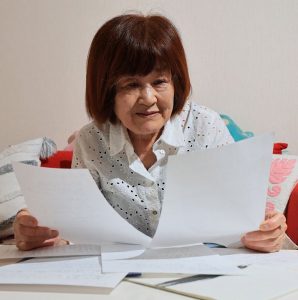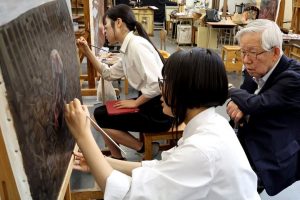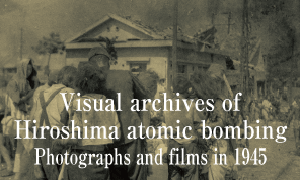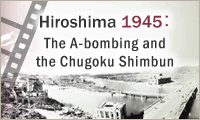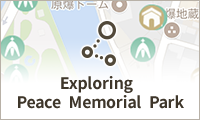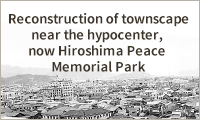Documenting Hiroshima 80 years after A-bombing: June 2025, personal account and drawing of A-bombing
Jun. 19, 2025
The work of passing on memories continues unbroken
by Michio Shimotaka, Staff Writer
In June 2025, the Hiroshima National Peace Memorial Hall for the Atomic Bomb Victims in Hiroshima’s Naka Ward, which marked its 24th anniversary, continues to collect personal accounts of the atomic bombing. The accounts are compiled in gray files and made available to the public in a reading room on the first basement floor. An account written in April by Keiko Takahashi, 83, a resident of Fujimino, Saitama Prefecture, is included in the brand-new 124th volume.
She has no memory of her earliest days at the time of the A-bombing, but her body still bears scars of war. “I want to be reborn with a beautiful body,” she said. Carrying indelible feelings, she wrote about hardships during the A-bombing and after the war that she heard from her mother.
Hiding keloid scars
Eighty years ago, on August 6, she was four years old. She was trapped under the rubble of her house, which collapsed in Minamikanon-machi (now part of Nishi Ward), two kilometers from the hypocenter, and suffered burns to her entire body. Her mother and younger sister were also injured, and they moved to Kyoto, where some relatives lived.
She had keloid scars on the backs of her knees and her left arm, and she was ridiculed for wearing a bandage over her injuries when she was in elementary school. She often missed physical education classes, where she had to wear shorts, and she rarely took part in athletic meets.
In her personal account, she wrote: “The keloid scars got worse and worse…Changing the bandages every morning and night was disgusting,” and “When I went to sleep and then suddenly woke up crying, ‘I’m scared. I’m scared.’ My family thought I had a mental illness. Today, it would be called post-traumatic stress disorder.”
During her high school days, she carried her schoolbag behind her body to hide the backs of her knees, which were visible beneath her school uniform. As a child, she loved fashionable things and once dreamed of becoming a fashion designer, but she gave up that dream.
When she was 39 years old, after getting married and giving birth, she underwent skin-graft surgery at a hospital in Tokyo, and her keloid scars became less noticeable than they had been in her early days. Today, she makes a daily habit of practicing yoga and sometimes enjoys traveling. However, when standing in rows during yoga lessons, she tends to take a spot on the far left to hide her left arm. When staying at a hot spring inn with her family or friends, she uses the bathtub in her room.
Until now, she had never spoken about her experience of the A-bombing. When she visited the Peace Memorial Museum more than 30 years ago, she felt choked up and soon went outside. However, this April, a leaflet inviting survivors to share personal accounts was delivered to her home through the local government by the Ministry of Health, Labour and Welfare. She thought, now that she was over 80, she could write about it. Finding it difficult to put her experience into words, she ended her account with: “I hope people around the world will never experience what we did.”
Based on A-bomb survivors’ testimonies, 207 drawings of the A-bombing were created
The work of passing on the indescribable memories of the A-bomb survivors continues through the paintbrushes of high school students. At Motomachi High School in Naka Ward, students have created 207 drawings depicting survivors’ memories of the A-bombing, based on their testimonies.
On June 6, Shingo Naito, 86, a resident of Minami Ward, met with Miyabi Nakahara and Ichigo Hashimoto, both 17 and in their third year of high school. He was six years old when he was exposed to the A-bombing at his home, 1.7 kilometers from the hypocenter. His house collapsed, and his mother desperately dug through the roof tiles and rescued his younger brother and sister. She took them to a first-aid station, but both later died.
The subjects of the drawings are his mother rescuing the two children and his father leading them to a first-aid station despite his severe burns. Mr. Naito and the students have met about ten times since last October, and he spoke about the situation in detail again on this day. He said, “The shirt wasn’t as clean as this,” and “My younger sister was a little smaller. She used to run around, following me.”
Mr. Naito began sharing his story after turning 80. When he spoke about his experience, he felt it was fading away, so he wanted it to be preserved through drawings. Ms. Nakahara, who was drawing his story, said, “As I didn’t actually see what happened, what I draw isn’t 100 percent accurate. But through drawings, I can express the feelings that an A-bomb survivor most wants to convey.” The drawings depicting the experiences of six A-bomb survivors, created by 15 students including the two, will be displayed soon.
(Originally published on June 19, 2025)

